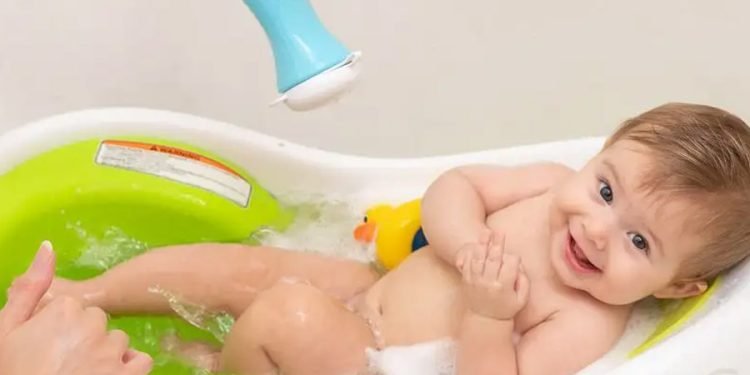You must have come across those baby bathing videos of them cooing and giggling all over the internet. Makes you want your own, right? Well, if you already have a baby you must love those precious moments. However, when and how to perform this common parenting ritual correctly frequently elicits further questions and, occasionally, anxiety.
The following are some frequently asked questions from parents regarding the timing, frequency, safety, and other aspects of bathing your baby. Also, do not forget to check out the best baby bathtub of this year, listed out only for you!
Now, When Should Babys Begin Their First Bath?
Over the past few years, the timing of a baby’s first bath has changed. Newborns are typically bathed within an hour or two of their birth. However, the World Health Organization (WHO) suggests delaying a baby’s first bath until 24 hours after birth, or at least 6 hours if a full day is culturally impossible.
But Why The Delay?
Delaying a baby’s first bath is now recommended for the following reasons:
● Blood Sugar and Body Temperature
Babies who receive baths immediately may be more likely to experience hypothermia. Some infants may also be more likely to experience hypoglycemia, a drop in blood sugar, as a result of the minor stress of an early bath.
● Breastfeeding and Bonding
Early breastfeeding success, skin-to-skin care, and mother-child bonding can all be disrupted if the baby is taken away for a bath too soon. When compared to infants who were bathed within the first few hours, those who were delayed for 12 hours saw a 166% increase in hospital breastfeeding success.
● Dry Skin
Vernix, a waxy white substance that covers a baby’s skin before birth, may have antibacterial properties and function as a natural moisturizer. To help protect a newborn’s delicate skin from drying out, the American Academy of Pediatrics (AAP) recommends leaving vernix on their skin for some time. Due to the high susceptibility of preemie skin to injury, this is highly crucial.
Note: After the initial breastfeeding period, babies whose mothers have HIV or Hepatitis will still be bathed to reduce the risk to hospital staff and family members.
How Often Do Babies Need a Bath Once They are Home?
Babies do not require daily baths because they rarely sweat or become filthy to require a full bath frequently. During the first year, 3 baths per week may be sufficient. The skin of your baby may become dry if you bathe them more often.
Can You Bath Your Baby Before The Umbilical Cord Comes Off?
You can give your baby sponge baths only after the umbilical cord has fallen off, which typically occurs around one or two weeks after birth. If the cord has not dried out and fallen off by the time the baby is two months old, see a doctor.
Here’s How You Can Give a Proper Sponge Bath
Sponge baths are not much different from a regular bath, but you don’t put your baby alone in the water even if you are using the best baby bathtub:
- Before you begin, be sure to have a basin of water, a dry towel, a damp washcloth that has been rinsed in soap-free water, and anything else you might need close at hand.
- Place your baby on a flat surface that is comfortable for both of you, such as a changing table, bed, floor, or counter near the sink.
- Use a fluffy towel or blanket to cover hard surfaces.
- If your child is on a surface over the floor, consistently utilize a safety belt or keep one hand on them to forestall falls.
- Wash their face first with the dampened cloth, taking care not to get water in their mouth or eyes.
- Then, dunk it in a bowl of water before washing the rest of the body and, at last, the diaper region.
- Keep the child warm. Cover only the areas of your baby’s body that you are actively washing during the sponge bath with a dry towel.
- Pay extra attention to the genital area, behind the ears, around the neck, and under the arms.
You may place your baby directly in water in the best baby bathtub once the umbilical area heals. Their initial baths ought to be as brief and gentle as possible. They may protest a little and if that happens you can give them a sponge bath for one or two weeks before trying the bath again. Most of the time, babies let you know when they’re ready.
10 STeps to Give Your Baby The Perfect Bath
Make use of a sink or the best baby bathtub you can find. The US Consumer Product Safety Commission recommends a sling that prevents your baby from sliding or a hard plastic baby bathtub with a sloped, textured surface. To ensure that it complies with the most recent safety standards, use only an infant bathtub that was produced on or after October 2, 2017. Some parents might prefer bathing their newborn in a bassinet, sink, or plastic tub lined with a clean towel.
- Do not use bath seats. A child can sit upright in an adult bathtub thanks to these seats but sadly, they are susceptible to tipping over.
- To ensure that you always have a hand on your infant, keep a towel and other bath supplies close at hand. You must bring the baby with you if you have forgotten something or need to answer the door or phone while taking a bath.
- To avoid scalding yourself or your child, turn on the cold water first (and off last) when filling the basin from the faucet. Check the water temperature by placing the inside of your wrist or elbow in it. You should feel warm, not hot when the water in the basin is 2 inches deep. The American Academy of Pediatrics (AAP) recommends that the faucet’s highest temperature not exceed 120 degrees Fahrenheit. Overheated tap water can quickly cause severe burns that necessitate hospitalization or even surgery.
- Keep the child warm by placing them in warm water as soon as you undress them. Support their head with one hand and lead them in, feet first, with the other. Pour warm water over their body frequently to keep them warm.
- Your baby’s skin may become dry from soap so use only mild ones with a neutral pH and no additives if heavily soiled areas require a cleanser. Remove the soap immediately from the skin.
- Make use of gentle shampoo or body wash to wash the baby’s hair two to three times per week.
- Cradle caps, a benign condition that affects many infants, can cause scaly patches to appear on your baby’s scalp. You can loosen the cradle caps scales by using a soft-bristled brush while shampooing, but if it doesn’t bother you, you can also leave it just as it is.
- Wash your baby’s face and hair with a gentle cloth, taking care not to scrub or pull at the skin. Cup your hand across their forehead as you rinse the shampoo off their head to direct the suds away from their eyes and toward the sides. Use the wet washcloth to wipe their eyes with plain, lukewarm water if any suds get in there.
- As soon as bath time is over wrap your baby’s head and body in a dry towel to keep them warm.
- Gently pat the baby dry and apply a small amount of hypoallergenic, fragrance-free moisturizing lotion immediately following a bath. This helps in the prevention of dry skin and eczema.
So What’s The Bottom Line on Giving Your Baby a Bath?
Never, ever, ever leave a baby alone in the bathtub because that’s where the majority of home drownings of children take place, and children under the age of one year account for more than half of bathtub deaths.
Give your baby extra time to splash and play in the water if they enjoy their bath. Your child’s fear of the water will decrease the more fun they have in the tub. Don’t rush unless they’re unhappy because bathing should be a very relaxing and calming experience.
Keep in mind that bathing your baby can be a breeze if you know the fundamentals. Just make sure your baby is safe and comfortable during bath time, and don’t forget to enjoy the special moments!
FAQs
Do you need a baby bathtub?
If you don’t have a baby bathtub you can just sit in your bathtub with your newborn on your lap. Once they are able to sit on their own (hello, baby milestone), they will be able to splutter and splash by themselves.
At what age can you use a baby bathtub?
They can sit up on their own with no assistance by 6 months of age and that’s when you can let them use the bathtub on their own by holding their head up.
What can I use instead of a baby bathtub?
You can use a bucket or storage container instead of a baby bathtub.












